Migrant Mother
"Destitute pea pickers in California. Mother of seven children. Age thirty-two. Nipomo Ca "
Florence Owens Thompson et trois de ses enfants :
en partant de gauche, Ruby (4 ans), Norma (1 an) dans les bras de sa mère, Katherine (5 ans)
photo Dorothea Lange - mars 1936 - version colorisée
Mère Colère contre Mère Courage - Le Monde 25.07.2013
Cette célèbre photo de Dorothea Lange voulait montrer la souffrance des pauvres blancs, contraints à migrer vers l'ouest par la Grande Dépression. Presque rien de cela n'était vrai.
En 1979, Florence Owens Thompson qui vit dans un mobile home se sent trahie par la photographe et exploitée : « Je regrette qu'elle ait pris ma photo. Je ne peux pas en tirer un seul centime. Elle ne m'a jamais demandé mon nom. Elle a dit qu'elle m'enverrait une copie et elle ne l'a jamais fait ». On découvre une femme aigrie et pleine d'amertume, bien loin du mythe glorieux.
http://www.lemonde.fr/culture/article/2013/07/25/mere-colere-contre-mere-courage_3453751_3246.html
L'article Migrant Mother (Mère Migrante) reproduit 5 autres clichés
http://en.wikipedia.org/wiki/Migrant_mother
Parmi les liens de l'article sur Dorothea Lange (1895-1965),
http://en.wikipedia.org/wiki/Dorothea_Lange
- Two women and a photograph
Giridhar Khasnis, The Hindu, 30.04.2006
Reconstructing the true picture behind a famous American photograph.
http://www.hindu.com/thehindu/mag/2006/04/30/stories/2006043000380500.htm
- The Other Migrant Mother, by Michael Stones
Un autre cliché nettoyé et recadré (le 3eme dans l'article Migrant Mother)
Florence Thompson's gravestone, in Empire California, carries the inscription « Migrant Mother – A Legend of the Strength of American Motherhood ». The iconic photograph made the legend but the repaired version of Photograph #4 strikingly depicts a truth about motherhood as old as humanity.
http://www.openphotographyforums.com/art_MICHAEL_STONES_001.php
- Alistair Scott, Great photos
http://www.alistairscott.com/lange/
http://www.alistairscott.com/greatphotos/
« Florence Thompson was born on an Indian reservation – "in a tepee," she said – in Oklahoma in 1903. Her father died when she was 13 months old, but her mother lived to be 108. Even before the Depression, Florence, her husband Cleo and their growing family left Oklahoma for California ». « Cleo died of tuberculosis in 1931 but a couple of years later, Florence became pregnant again from her relationship with a wealthy Oroville businessman and gave birth to son. Subsequently, James R. Hill, a butcher from Los Angeles, came into her life and a daughter was born in March 1935. (Florence had three more children by Hill. She married hospital administrator George Thompson well after World War II) »
l'écouter ou la lire
Farming in the Thirties, Oakies : http://www.livinghistoryfarm.org/farminginthe30s/water_06.html
http://www.hindu.com/thehindu/mag/2006/04/30/stories/2006043000380500.htm
>> This image was selected as picture of the day on Wikimedia Commons for 24 February 2008.
Roy Stryker called Migrant Mother the ultimate photo of the Depression Era. "[Lange] never surpassed it. To me, it was the picture … ». Edward Steichen described the photo taken for the FSA as « the most remarkable human documents ever rendered in pictures ».
Se payer une icône est un exercice littéraire d'été intéressant. L'article oppose l'aigreur du point de vue de la mère migrante et les inexactitudes dans le discours de la photographe. Mais l'impact de l'image va au-delà du différend en partie financier. La postérité de la photo mériterait à elle seule une analyse approfondie.
(cf. un autre cliché très célèbre, celui de Kim Phuc, la fille de la photo, en 1972 : la photo en noir et blanc de Nick Ut est davantage connue et a plus d'impact que les vidéos en couleur de la BBC).
- Il faudrait aussi mettre l'image dans le contexte social de la Grande Dépression,celui qui est au coeur du livre Les raisins de la colère, le roman de Steinbeck et le film de John Ford. Voir ou revoir la comparaison des deux camps d'hébergement des migrants (le privé, le gouvernemental), ou écouter Henry Fonda.
http://en.wikipedia.org/wiki/The_Grapes_of_Wrath
http://fr.wikipedia.org/wiki/Raisins_de_la_col%C3%A8re.
La crise de 1929 a disparu des programmes scolaires, sous l'influence de Jacques Marseille. Keynes, Roosevelt et le New Deal sont détestés par les libéraux et la droite patronale pour qui toute loi sociale est le début d'une catastrophe menant au communisme.
- Rappeler le rôle de la Farm Security Administration - Office of War Information
The FSA-OWI Photograph Collection forms an extensive pictorial record of American life between 1935 and 1944 ... There are over 107,000 photographic prints in the collection, consisting of about 77,000 images produced by photographers under Roy Stryker's direction and about 30,000 photographs (without corresponding negatives) acquired from other sources.
http://memory.loc.gov/ammem/fsahtml/fabout.html
Les noms des photographes sont cités dans l'article de Wikipedia
http://en.wikipedia.org/wiki/Farm_Security_Administration#The_photographers
Confronter cette photo très célèbre aux autres clichés de Dorothea Lange présents sur Wikimedia Commons
http://commons.wikimedia.org/wiki/Category:Dorothea_Lange
par exemple
Drought refugees from Oklahoma camping by the roadside.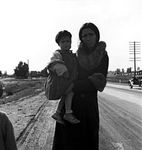
On U.S. 99. Near Brawley, Imperial County. Homeless mother and youngest child of seven walking the highway
Guide to the Lange collection - (Depression-Era Street Scene Photos)
http://www.oac.cdlib.org/findaid/ark:/13030/ft3f59n5wt/
Comparer avec les photos prises par les autres photographes de la FSA-OWI
http://commons.wikimedia.org/wiki/Category:FSA-OWI
ou via Google images : Dorothea Lange Great Depression
http://tinyurl.com/dlange-greatdep
http://tinyurl.com/fsa-greatdep
Comparer avec les sujets abordés dans les collections du magazine Life (dont Migrant Mother)
ou dans le site Old-picture - American Life in the 1930s (gens connus, anonymes,sujets sérieux ou futiles...)
http://www.old-picture.com/american-life-1930s-index-001.htm
Au total, cette très célèbre photo, et les commentaires faits depuis la mort de Dorothea Lange en 1965 en disent sans doute davantage sur les moeurs de la presse écrite que sur la détresse des Américains face à la grande crise des années 1930.
rappel : d'autres pistes dans la page Roosevelt et le New Deal
.

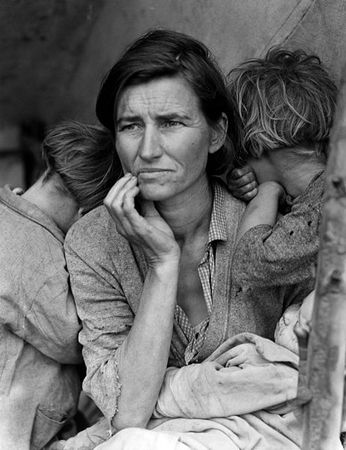

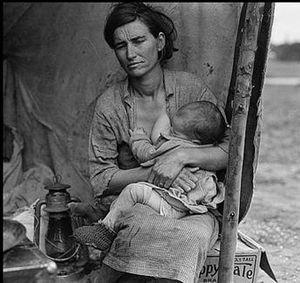
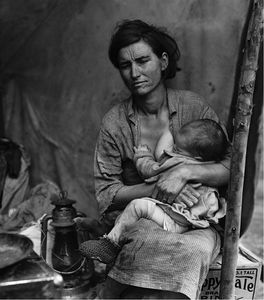
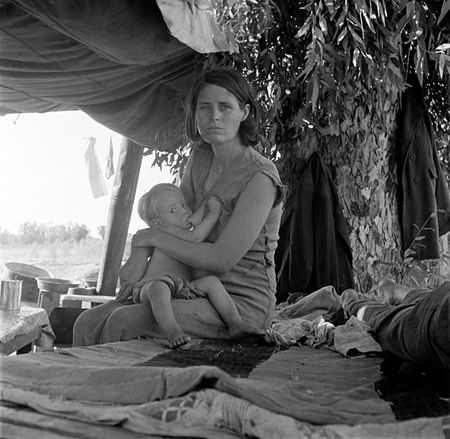


/http%3A%2F%2Fstorage.canalblog.com%2F33%2F67%2F161889%2F129702862_o.jpg)
/http%3A%2F%2Fstorage.canalblog.com%2F79%2F29%2F161889%2F128378218_o.jpg)
/http%3A%2F%2Fstorage.canalblog.com%2F61%2F96%2F161889%2F118216716_o.jpg)
/http%3A%2F%2Fstorage.canalblog.com%2F81%2F38%2F161889%2F116206772_o.jpg)
/https%3A%2F%2Fstorage.canalblog.com%2F02%2F17%2F161889%2F117651881_o.jpg)
/https%3A%2F%2Fstorage.canalblog.com%2F19%2F63%2F161889%2F117610470_o.jpg)